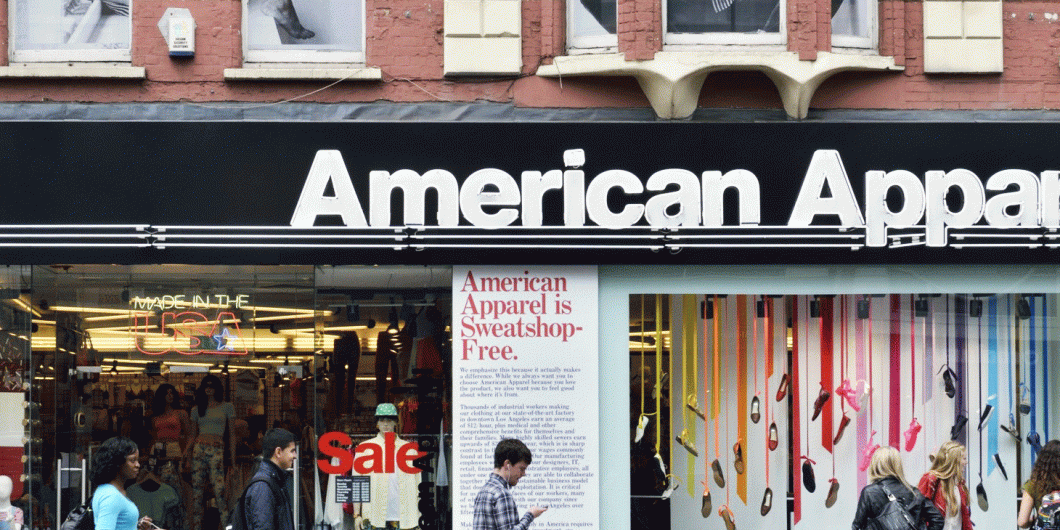Buying local is an increasingly more popular trend, but are you truly ready to pay more for products made on local soil? The new head of American Apparel wants to test this theory.
The new CEO of American Apparel has decided to offer consumers a Made-in-the USA option. Gildan, the Montreal company that recently purchased the brand, will now sell the same item in two versions: one “regular” and one “local” version that could cost up to 25% more. A true test of how dedicated the brand’s fans are to buying local!
For Gildan, which spent $88 million to buy American Apparel earlier this year, this is also a way to see whether consumers are actually ready to back their avowed interest in buying local (according to surveys, anyway) with their wallets. And furthermore, a convenient way to transfer any hard feelings over factory closures in Los Angeles to (eventually disconnected) consumers.
Gildan wants to boost online sales and is betting that the acquisition of American Apparel will be more effective than building a brand image for its own products. So what was actually bought is the popularity of the California brand with a certain youth market. But even if it acquired the brand’s reputation and ethos, the multinational Montreal t-shirt company has not embraced a commitment to locally made. Rather, Gildan reckons that where a product is manufactured is of little importance in the textile industry. Statistics back it up: today, only 2% of clothing purchased in the U.S is made locally, whereas in 1960, it was over 95%.
Do you know where the shirt you’re wearing today was made? Locally made becomes even more problematic for international empires. Is Starbucks still considered a local Seattle business? What about the car dealership in Ottawa that sells Japanese cars built in Ontario… are they still local? What coffee brand is more Canadian, Second Cup or our beloved Tim Horton’s, which is now owned by Burger King?
However, in the case of American Apparel, locally made is part of the brand’s foundations. Not understanding this could be damaging to Gildan. During the bankruptcy clearout, Gildan bought the brand, but it also came with a production chain based in Los Angeles. With such divergent points of view, this marriage will be off to a rocky start.
American Apparel built a reputation as a staunch defender of locally made. Gildan sells more than $2.5-billion worth of foreign-made clothing. American Apparel gained fame with bold advertising campaigns that were sometimes sexy, sometimes sexist. Gildan likes to keep a low profile for fear of once again being pilloried for paying low wages abroad or for its tax strategies. How will this iconoclastic brand maintain its identity now that it belongs to the Montreal company? Will American Apparel survive in the Gildan age? All bets are off.
The uncertainty underlines a deeper concern: if Gildan doesn’t share its brand vision, why did it buy the bad-boy California company? Ignoring the foundations that this brand was built on could be a fatal error.
In many cases, consumers are ready to pay more for a product made in the original workshop or factory. The authenticity of where it’s made is a contagion, the traces of which can be transferred to the product. In a study looking at Levi’s jeans, clients were willing to pay more for a pair of jeans made in the San Francisco factory, originally constructed in 1906. Considering that the alternative is a pair made in southeast Asia, the interest in buying authentic denim probably stems from ecological awareness. However, the study also revealed that consumers prefer original factory manufacturing even if the alternative is a more modern factory located across the street.
Simply put, where a product is made does imbue that product with certain values. Can Gildan afford to lose contact with this strong identity and still hope to sell American Apparel over the long term?
With this new sales tactic, Gildan is trying to make everyone happy: maintaining an aura of American Apparel’s insouciance, without risking a drop in sales due to less expensive brands. This approach—only keeping the brand values that are most profitable—is more opportunistic than engaged.
Some 45% of Canadians claim they make efforts to buy locally made goods. When it comes time to buy your next t-shirt, will you choose local or cheaper?
This article was originally published online in French on L’actualité.
Image from the Chicago Tribune


